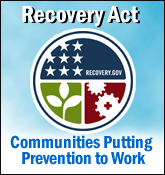Diabetes
Successes and Opportunities for Population-Based Prevention and Control
At A Glance
2011

On this Page
What is Diabetes?
The Disease
Diabetes is a disease in which the body has a shortage of insulin, a decreased ability to use insulin, or both. Insulin is a hormone that allows glucose (sugar) to enter cells and be converted to energy. When diabetes is not controlled, glucose and fats remain in the blood and, over time, damage vital organs.
Type 1 diabetes usually is first diagnosed in children and young adults, although it can occur at any age. Type 1 diabetes is an autoimmune disease that may be caused by genetic, environmental, or other factors. It accounts for about 5% of diabetes cases. There is no known way to prevent it, and effective treatment requires the use of insulin.
Type 2 diabetes accounts for 90%–95% of diabetes cases and is usually associated with older age, obesity and physical inactivity, family history of type 2 diabetes, or a personal history of gestational diabetes. Diabetes rates vary by race and ethnicity, with American Indian, Alaska Native, African American, Hispanic/Latino, and Asian/Pacific Islander adults about twice as likely as white adults to have type 2 diabetes. Type 2 diabetes can be prevented through healthy food choices, physical activity, and weight loss. It can be controlled with these same activities, but insulin or oral medication also may be necessary.
Gestational diabetes is a form of glucose intolerance that is diagnosed during pregnancy. Gestational diabetes occurs more often in African American, Hispanic/Latino, and American Indian women, as well as in women who are obese or have a family history of type 2 diabetes. It requires treatment to bring maternal blood glucose to normal levels and avoid complications in the infant.
Other types of diabetes result from specific genetic conditions (such as maturity-onset diabetes of youth), surgery, medications, infections, pancreatic disease, and other illnesses. Other types of diabetes account for less than 5% of all diagnosed cases.
Diabetes Is Common, Disabling, and Deadly
-
25.8 million people in the United States (8.3% of the population) have diabetes. Of these, 7.0 million have undiagnosed diabetes.
-
In 2010, about 1.9 million new cases of diabetes were diagnosed in people aged 20 years or older.
-
If current trends continue, 1 of 3 U.S. adults will have diabetes by 2050.
-
Among adults, diabetes is the leading cause of new cases of blindness, kidney failure, and amputations of feet and legs not related to accidents or injury.
-
Diabetes was the seventh leading cause of death listed on U.S. death certificates in 2007.
-
A person with diabetes has a shorter life expectancy and about twice the risk of dying on any given day
as a person of similar age without diabetes.
The Financial Cost
-
Total costs (direct and indirect) of diabetes in 2007: $174 billion.
-
Direct medical costs in 2007: $116 billion.
-
Indirect costs (related to disability, work loss, premature death) in 2007: $58 billion.
-
On average, medical expenses for a person with diagnosed diabetes are more than twice as much as the expenses of a person without diabetes.
Diabetes Is Preventable and Controllable
Preventing Type 2 Diabetes
People with prediabetes are at high risk of developing type 2 diabetes. Their blood glucose levels are higher than normal, but not high enough to be classified as diabetes. An estimated 79 million U.S. adults had prediabetes in 2010. Group support programs that help people with prediabetes develop better eating habits, improve their coping skills, and increase their physical activity level have been proven to be effective.
People with prediabetes who lose 5%–7% of body weight and get at least 150 minutes a week of moderate physical activity can reduce the risk of developing type 2 diabetes by 58%.
Controlling Diabetes
Disability and premature death are not inevitable consequences of diabetes. Physical activity and dietary interventions, self-management training, ongoing support, and, when necessary, medications can help control the effects of diabetes. By working with a support network and health care providers, a person with diabetes can prevent premature death and disability.
For example,
-
Reducing A1c (a measure of blood glucose control) by one percentage point can reduce the risk of eye, kidney, and nerve diseases by 40%.
-
Controlling blood pressure can reduce the risk of heart disease and stroke by 33%–50% and the risk of eye, kidney, and nerve diseases by 33%.
-
Improving control of low-density lipoprotein (LDL) cholesterol can reduce cardiovascular complications by 20%–50%. Treating diabetic eye disease with laser therapy can reduce the risk of loss of eyesight by 50%–60%.
-
Accessing comprehensive foot care programs can reduce amputation rates by 45%–85%.
Important Achievements in Diabetes Control
On average, people with diabetes are living longer. Public health efforts designed to prevent and control this disease have played a role in reducing
-
Hospitalization rates related to diabetes and hospitalization rates for cardiovascular disease among people with diabetes.
-
Percentage of adults with diabetes who report visual impairment.
-
Rate of new cases of diabetes-related kidney failure.
CDC's Response
To reduce the preventable burden of diabetes, CDC's Division of Diabetes Translation conducts many activities that involve public health leadership, partnerships, research, policies, and programs that translate science into practice. These activities include the following:
Measuring the Public Health Burden
CDC is a key source of data that can be used to monitor health at state and local levels, guide clinical practices and policy decisions, and provide people with the information they need to take action to improve their own health.
For example, CDC's National Diabetes Surveillance System (NDSS) maintains diabetes-related data from national and state surveys. NDSS data are not available from any other source. The data are used by states and local communities to identify trends in diabetes and its complications, detect changes in health care practices, facilitate diabetes program planning, develop educational materials, and allocate resources.
To view national and state trends for diabetes, obesity, and leisure-time physical inactivity, as well as data for your county, go to http://apps.nccd.cdc.gov/DDTSTRS.
Performing Diabetes Research
CDC scientists conduct research and share findings with health care systems and communities. Special emphasis is placed on eliminating health disparities among populations at higher risk. Examples of current research include the following:
-
Surveillance, Natural History, Quality of Care, and Outcomes of Diabetes Mellitus with Onset in Childhood and Adolescence: This 5-year program is expected to provide estimates of trends in the incidence of diabetes among children and youth aged 0–19 years and support research to assess the incidence of diabetes-related complications, quality of care, quality of life, and mortality.
-
Natural Experiments and Effectiveness Studies to Identify the Best Policy and System Level Practices to Prevent Diabetes and Its Complications: This 5-year program will test how health system, community, and legislative policies affect the risk of diabetes and its complications through rigorously designed, controlled, longitudinal studies.
-
Translating Research into Healthy Eye and Vision Loss Prevention: This 5-year program was developed to close the gap between existing practice and optimal evidence-based eye care and to reduce disparities in eye health.
Working to Reduce Disparities
CDC provides funding and technical assistance for diabetes programs in all 50 states, the District of Columbia, 6 U.S. Associated Pacific Islands, Puerto Rico, and the U.S. Virgin Islands. These programs work to
-
Prevent diabetes among people at highest risk.
-
Promote adoption of diabetes care guidelines in health care settings.
-
Help state Medicaid programs monitor quality care outcomes among people with diabetes.
-
Educate health care providers and the public about optimal diabetes care and self-management.
-
Reduce health disparities through approaches that have been proven to work.
For example, the National Diabetes Prevention Program is designed to bring evidence-based lifestyle interventions for preventing type 2 diabetes to communities. It is based on the Diabetes Prevention Program research study led by the National Institutes of Health (NIH) and subsequent real-world studies. The inaugural partners of this program are the YMCA of the USA (which delivers the intervention) and the UnitedHealth Group (which provides data support and reimbursement through subsidiary UnitedHealthcare).
The National Program to Eliminate Diabetes-Related Disparities in Vulnerable Populations is a 5-year program that promotes community interventions that are designed to reduce the risk factors that influence health disparities. The National Diabetes Education Program (NDEP), jointly led by CDC and NIH, develops and disseminates educational information on how to prevent and control diabetes to population groups affected by diabetes, health care professionals, employers, and insurers. NDEP's educational resources and tools are available online in English, Spanish, and 15 Asian or Pacific Islander languages at http://www.yourdiabetesinfo.org.
The Native Diabetes Wellness Program focuses on American Indian/Alaska Native and Pacific Islander populations that are disproportionately affected by diabetes. This program works with 17 tribes and tribal organizations and with Pacific Islander groups to support community efforts that promote access to traditional local foods and to implement local policies to sustain these efforts. The program also has provided more than two million copies of the Eagle Books series on healthy lifestyles for young children to schools, libraries, and other organizations. For more information, go to http://www.cdc.gov/diabetes/projects/diabetes-wellness.htm.
Success Stories
Minnesota Diabetes Prevention and Control Program: Raising Awareness to Improve Health
Working with a diverse group of partners, health officials in the Minnesota Diabetes Prevention and Control Program (DPCP) developed a strategy focused on raising awareness of prediabetes and preventing type 2 diabetes as a way to improve the health of state residents. This strategy included collecting data, disseminating guidelines, increasing awareness of resources, and building infrastructure. For example, health officials
-
Collected information on key diabetes risk factors, as well as background data and evidence, and used mathematical models to demonstrate the burden of diabetes.
-
Worked to ensure that evidence-based guidelines for addressing chronic disease risk factors and prediabetes care were adopted by health care providers in the state.
-
Worked to increase awareness of the importance of preventing type 2 diabetes among populations at risk.
Partners in these efforts included public health and health care systems, local and state employers, health insurers, legislators, professional and community groups, consumers, academic institutions, and quality improvement groups. These partnerships helped shape comprehensive health reform in Minnesota. Key provisions in the law, which was enacted in May 2008, included reimbursement for diabetes preventive services and creation of the $47 million Statewide Health Improvement Program. The Minnesota DPCP and other groups also worked to build the infrastructure for a 16-week, evidence-based program called Individuals and Communities Acting Now to Prevent Diabetes (I CAN Prevent Diabetes). This program is based on the landmark Diabetes Prevention Program study, which showed that people at high risk of developing type 2 diabetes could prevent or delay the disease by losing weight and being physically active.
The I CAN Prevent Diabetes program works with health care providers, insurers, and employers to increase participation and reimburse the cost of prediabetes services. As a result of these efforts, the percentage of prediabetes cases detected in Minnesota increased from 2.4% in 2004 to 5.3% in 2008, and program participants lost an average 5.7% of their body weight.
Ninety lifestyle coaches were certified to deliver the program in multiple settings for diverse groups, including Hmong, Somali, American Indian, and Hispanic populations, as well as for people who are hearing impaired. Program partners include Steps to a Healthier Minnesota and its community coalitions, the YMCA, UnitedHealth Group, health care systems in the state, industry groups, senior centers, and Indiana University.
Kansas Diabetes Prevention and Control Program: Strengthening the Quality of Care
In Kansas, about 180,000 (8.5%) adults have been told they have diabetes; another 120,000 are estimated to have undiagnosed diabetes. The rate of obesity—a major risk factor for type 2 diabetes—among Kansas adults has more than doubled in recent years, from 13.1% in 1992 to 28.8% in 2009.
To help improve the health of people with diabetes, the Kansas Diabetes Prevention and Control Program launched the Kansas Quality of Care Project in 2004 to collect information about the quality of diabetes preventive services available in the state. The program was later expanded to include information on services for people with high blood pressure and high cholesterol, which are often associated with diabetes.
Across the state, 38 health care organizations working with 68 clinics participate in this project. Each clinic collects information about patient and clinic-level measures of diabetes and blood pressure control and reports it weekly to a central registry. These measures include the percentage of patients who receive regular A1c tests (a measure of blood glucose control), annual eye and foot exams, and regular blood pressure checks, as well as the percentage who have had their body mass index (BMI, a measure of body fat) calculated.
As of April 2011, the registry had data on 15,275 patients. Health officials and health care providers can use the data to analyze the quality of diabetes care for a single clinic, a group of clinics, all clinics in one county, or all clinics statewide. An analysis of state data for 2005–2008 found that the percentage of patients who got recommended preventive services increased from 46% to 87% for A1c tests, from 19% to 43% for eye exams, from 26% to 56% for foot exams, and from 36% to 88% for blood pressure checks. The percentage of patients who had their BMI calculated increased from 9% to 73%.
In 2010, the Kansas Quality of Care Project began requiring health care organizations to participate in quarterly quality improvement projects, such as increasing the number of patients who receive chronic disease self-management education.
Native Diabetes Wellness Program Honors Traditional Culture to Promote Health
Just 60 years ago, type 2 diabetes was rare in Native American communities. Today, it is a common and serious condition among American Indian and Alaska Native (AI/AN) people, woven together with complex interactions that have environmental, sociological, and historical roots. During 1994–2004, the prevalence of diagnosed diabetes doubled among AI/AN adults aged 35 years or younger who are served by the Indian Health Service (IHS) and increased 68% among AI/AN youth aged 15–19 years. The risk of developing heart disease is nearly four times higher for AI/ANs with type 2 diabetes than for those without this disease.
To address these health disparities, the CDC Native Diabetes Wellness Program (Wellness Program) was established. Listening sessions with tribal leaders and community members guided the program's development. Founded on principles that honor the traditional knowledge of AI/AN cultures as key resources for improving health in tribal communities, the program values collaborations with tribal communities and organizations across the country and partners such as IHS, the National Institutes of Health, and other federal agencies.
In 2008, the Wellness Program established 5-year cooperative agreements with 17 AI/AN tribes and tribal organizations to support community efforts to restore and enhance access to locally grown and gathered traditional foods, such as tepary beans, seaweed, and squash, and to foster participation in traditional physical activities such as stickball and canoeing.
As part of the project, tribal programs across the country are identifying community-developed strategies and using storytelling as a way to convey them. One example is the Standing Rock Sioux Tribe's Native Gardens Project. The tribe, which borders North Dakota and South Dakota, is reclaiming the traditions of companion gardening, hunting, and gathering. Indigenous foods, including squash, melons, and beans from local farms and timpshila (prairie turnips), are made available through summer and winter farmers' markets.
A farmers' market in one district held 19 market days in 2010, with hundreds of participants. These events included social gatherings and demonstrations on food preparation. More than 60% of vouchers given to tribal elders in 2010 to buy locally grown foods were redeemed, generating $9,000 in sales and encouraging local farmers to participate. Market activities also go hand-in-hand with strategies recommended by CDC to promote health and prevent obesity through community interventions.
Project partners include the Standing Rock Sioux Tribe Nutrition for the Elderly Program, the U.S. Department of Agriculture's Senior Farmers' Market Program, the North Dakota State University Extension Service Sioux County, the Boys and Girls Clubs, and National Relief Charities.
The project uses Lakota names for foods and seasons, providing a natural way for elders to teach the Lakota language to tribal children. Stories that reinforce the wisdom of traditional ways are being remembered and retold in homes, schools, and communities. Through stories shared with the Wellness Program, public health leaders learn to respect the connection of time-honored community approaches, wisdom, and values to health and the prevention of chronic diseases.
For more information please contact the
Centers for Disease Control and Prevention
National Center for Chronic Disease Prevention and Health
Promotion
4770 Buford Highway NE, Mailstop K-10, Atlanta, GA 30341-3717
Telephone: 800-CDC-INFO (232-4636) • TTY: 888-232-6348
E-mail: cdcinfo@cdc.gov • Web:
http://www.cdc.gov/diabetes
Contact Us:
- Centers for Disease Control and Prevention
National Center for Chronic Disease Prevention and Health Promotion (NCCDPHP)
4770 Buford Hwy, NE
MS K-40
Atlanta, GA 30341-3717 - 800-CDC-INFO
(800-232-4636)
TTY: (888) 232-6348
8am-8pm ET
Monday-Friday
Closed Holidays - Contact NCCDPHP





